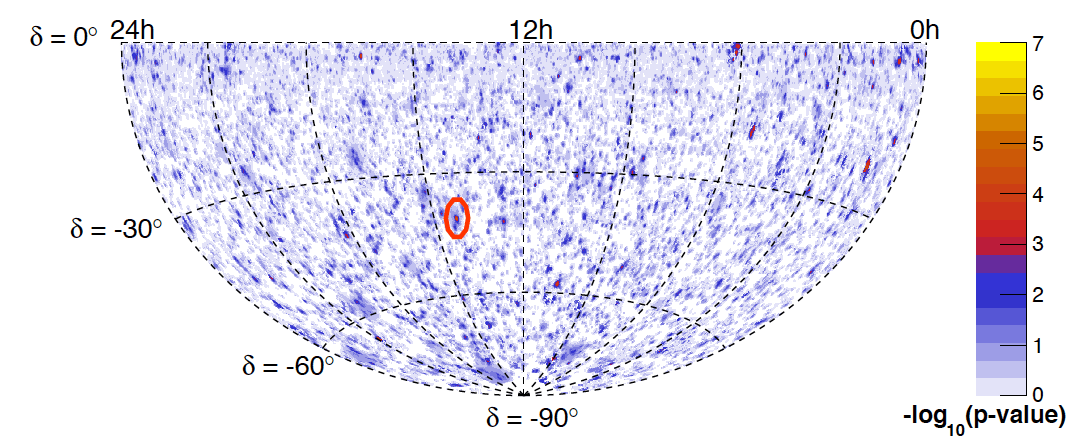Teamwork makes the dream work. Especially when that dream is to find sources of elusive particles called neutrinos.
Neutrinos are chargeless, nearly massless subatomic particles. These elusive particles are abundantly produced in nuclear fusion processes in our sun or the natural radioactivity of Earth. In rare cases, we also observe high-energy neutrinos from outer space, known as astrophysical neutrinos. They fly through light-years of space at close to the speed of light without being tugged around by magnetic fields or other forces; this makes them ideal astronomical messengers, as they bring us information from the most enigmatic objects in the cosmos. But we still don’t know where they originate.
The IceCube Neutrino Observatory in Antarctica is one experiment looking for sources of these enigmatic particles. IceCube does this with an array of 5,160 optical detectors buried in a cubic kilometer of South Pole ice; when a neutrino from outer space reaches Antarctica with enough energy, it can hit an atom in the ice and produce another particle that flies through IceCube, trailed by a cone of light called Cherenkov radiation. That cone of light triggers the detectors it passes, leaving clusters of lit-up detectors behind it.
Meanwhile, floating in the Mediterranean Sea is a similar neutrino experiment called ANTARES. It relies on the same principle as IceCube: It’s another three-dimensional array of optical detectors in a transparent medium (here, water instead of ice). If a high-energy neutrino hits an atom in the water, it will produce a particle and Cherenkov light that triggers the optical modules in the sea.
The IceCube Collaboration recently conducted a combined IceCube-ANTARES search for neutrino point-like and extended sources in the southern sky. They didn’t find any significant evidence for cosmic neutrino sources, but the analysis shows the strong potential for combining data sets from both experiments. Their results were recently submitted to The Astrophysical Journal.

It’s an exciting time for neutrino astronomy. IceCube’s past few years of research have yielded promising results, including the discovery of the first evidence of neutrinos coming from an astrophysical source. But the origins of most of the astrophysical neutrinos that reach Earth remain unknown.
So researchers around the world are continuing to look for neutrino sources. Giulia Illuminati of the Instituto de Física Corpuscular in Valencia, Spain, led this search, which combined data sets from IceCube and ANTARES.
“The motivation behind this analysis lies in the fact that ANTARES and IceCube, thanks to their different sizes and locations, complement each other when looking for neutrino sources in the southern sky,” she says.
ANTARES’s location in the Mediterranean results in a lower background for neutrino source hunting in the Southern Hemisphere, while IceCube’s larger size gives it a higher detection capability. Together, these characteristics mean an increased chance to detect sources of astrophysical neutrinos in the southern sky.
Illuminati and her collaborators performed five types of searches for point-like and extended sources of astrophysical neutrinos using ANTARES and IceCube data. (Technically, all neutrino sources are “extended,” but when they appear on the celestial sphere with a size smaller than IceCube’s angular resolution, they cannot be resolved and are called “point-like.”)
In the first two searches, they scanned the full southern sky and a restricted region around the Galactic Center to look for significant emission of cosmic neutrinos from point-like and extended sources. In the third search, they investigated the positions of 57 astrophysical objects in a predefined list of candidate point-like emitters of high-energy neutrinos. Finally, they performed dedicated searches at the locations of two promising neutrino source candidates: the supermassive black hole Sagittarius A* and the shell-type supernova remnant RXJ 1713.7-3946.
Ultimately, they did not find any significant point-like or extended neutrino emission, but they derived upper limits on the neutrino flux from the various analyzed sources. Even without a significant discovery, this analysis proved the high potential of joint searches for neutrino sources with ANTARES and IceCube. By combining the data sets of the two detectors, the researchers were able to improve the sensitivity in different regions of the southern sky by about a factor of 2 compared to individual analyses.
“These results strongly motivate a joint analysis of future data sets, not only of the ANTARES and the IceCube telescopes but also of the future detectors KM3NeT and IceCube-Gen2,” says Illuminati.
info “ANTARES and IceCube Combined Search for Neutrino Point-like and Extended Sources in the Southern Sky,” IceCube Collaboration: M. G. Aartsen et al., The Astrophysical Journal 892 (2020) 92, iopscience.iop.org, arxiv.org/abs/2001.04412